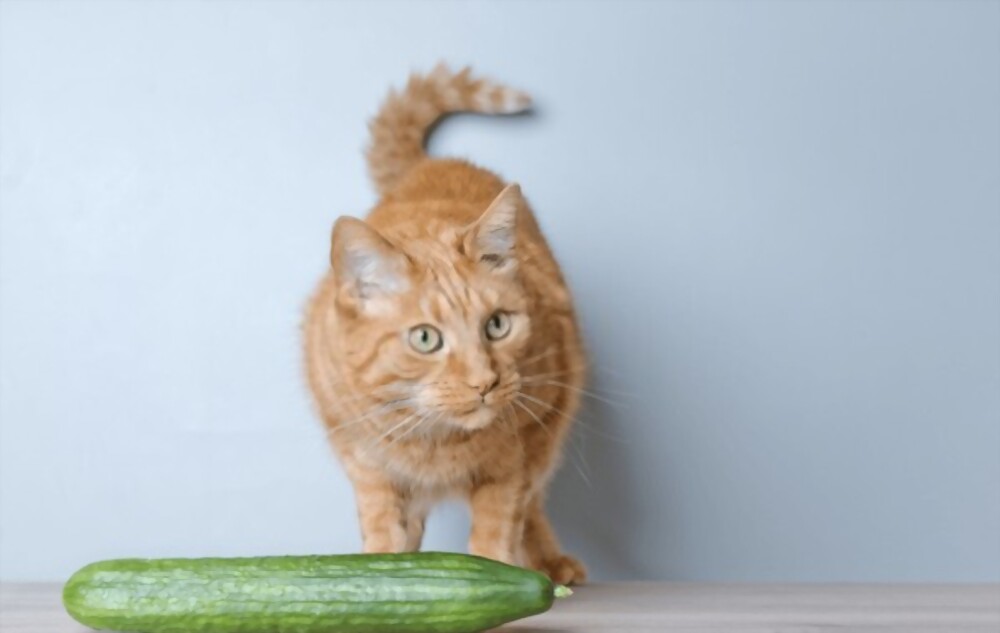If you’ve ever come across videos of cats leaping into the air in alarm at the sight of a cucumber, you might wonder why these seemingly harmless vegetables provoke such strong reactions. While it may seem amusing at first glance, it’s essential to understand that causing fear or distress in animals is not recommended. However, understanding the reasons behind certain behaviors can help us provide better care for our feline companions. In this blog post, we will explore why some cats exhibit fear or startled responses when confronted with cucumbers.
1.The Element of Surprise
One of the main reasons why cats may react fearfully to cucumbers is the element of surprise. Cats are known for their cautious nature and heightened senses, particularly their acute hearing, and keen eyesight. When a cucumber is placed behind a cat without its knowledge, the sudden appearance can startle the cat, triggering a fear response. The unfamiliar object in their environment may be perceived as a potential threat, causing the cat to react defensively. This response is not limited to cucumbers alone but can occur with any object unexpectedly introduced into the cat’s environment.
2.Instinctual Response to Predators
Cats have evolved as predators and have a built-in survival mechanism that makes them wary of potential threats. Cucumbers, with their elongated shape and green color, can bear a resemblance to snakes or other predators in the eyes of a cat. This instinctual response can be attributed to their ancestors’ survival instincts, where any sudden movement or the presence of an unknown object could signify danger. It is believed that cats have a natural predisposition to be cautious and reactive to things that resemble potential predators. This instinctual response may be particularly evident in cats that have had previous negative encounters with snakes or other dangerous animals.
3.Associative Learning
Another reason why cats may fear cucumbers is due to associative learning. If a cat encounters a cucumber and gets startled by it, it may associate the presence of cucumbers with fear or discomfort. This learned response can be generalized to other situations as well, causing the cat to exhibit fear or avoidance behavior when confronted with similar objects or situations in the future. Associative learning plays a significant role in shaping an animal’s behavior and can have lasting effects on its reactions. It’s important to note that this response is specific to individual cats and may not apply to all cats universally.
4.Environmental Factors
Apart from the inherent traits and instincts of cats, the environment they are in also plays a role in their reactions. If a cat is already in a heightened state of stress or anxiety, any sudden change or unfamiliar object introduced into its environment can intensify its fear response. Factors such as changes in their living arrangements, exposure to loud noises, or previous traumatic experiences can contribute to their overall sensitivity and reaction to stimuli. It is crucial to provide a secure and stable environment for cats, ensuring they feel safe and comfortable to minimize any potential fear-inducing situations.
5.Individual Personality and Sensitivities
Each cat has its unique personality, sensitivities, and past experiences that shape their responses to different stimuli. While some cats may exhibit fear or startled responses to cucumbers, others may not be affected at all. It’s important to observe and understand your cat’s temperament and avoid subjecting them to unnecessary distress. Respecting their boundaries and providing a secure environment tailored to their needs is crucial for their overall well-being.
6.Startle Response
Cats have a natural startle response, which is an instinctive reaction to sudden movements or loud noises. This response is rooted in their survival instincts and serves as a means of self-protection. When a cucumber is placed behind a cat without its knowledge, the sudden appearance can trigger this startling response. The cat’s reflexive jump or leap can be seen as an attempt to distance itself from the perceived threat. The startle response to cucumbers is not exclusive to cats but can be observed in other animals as well.
7. Previous Negative Experiences
Negative experiences or traumatic events in a cat’s past can shape its future reactions to similar situations or objects. If a cat has had a previous negative encounter with a cucumber or an object resembling a cucumber, it can create a lasting association of fear or discomfort. This learned response can be deeply ingrained in their memory and influence their behavior when confronted with cucumbers or similar objects. Understanding a cat’s history and providing a supportive and reassuring environment can help mitigate its fear response.
While the fear response exhibited by some cats towards cucumbers may be amusing to observe, it is important to remember that causing fear or distress in animals is not recommended. Cats have their unique personalities, sensitivities, and past experiences that shape their responses to different stimuli. It is crucial to provide a safe, secure, and predictable environment for our feline companions, respecting their boundaries and avoiding unnecessary distress. By understanding the various reasons behind their fear of cucumbers, we can create an environment that promotes their overall well-being and helps them feel comfortable and secure. Let’s prioritize the emotional and mental health of our beloved cats and ensure their happiness and contentment in our care. gate their fear response.

